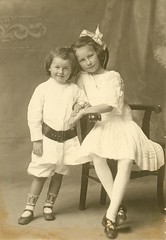This has always been one of my favorite photos of my father, the little boy on the left. We had it in our living room in a stand-up frame every since I could remember. At The Farm--we always call it that--(1950-1956) it was on the low painted bookcases above the complete set of Nathaniel Hawthorne. Blue bindings; not very strong ones. Cheap yellowing paper. His novel I failed to finish was called The Marble Faun. It didn't make sense to me in my 13th or 14th summer. But I did love a slender volume of a play by Tennessee Williams called Summer and Smoke. That gave me an impossible view of male/female relationships. The cool hands of MIss Alma were my idea of the comfort one should be able to give to the suffering male. I don't know why this was such an appealing idea at the time, but I still remember its power.
I seem to remember hearing that this photo was taken back east when he and Mary LIllian traveled with a relative (an aunt?) back to Arkansas (or Tennessee?) to visit the relatives his parents had left behind when they went to New Mexico (where my father was born) and Arizona (where he did most of his growing up). I think this was the same train trip when my father was locked into the restroom while the train was in the station (a precaution they took against stowaways) and had a strong experience of terror when his screams brought no attention. He was freed when they unlocked the room after the train started up again. He told me about this when he was in his late seventies. He maintained close attachment to his family all his life. He wrote his mother a letter, in his neat, easily readable handwriting, every Sunday for many years. He visited his brother and sisters whenever he went West on business. But he didn't talk about them as much as my mother talked about her family, so I felt I knew the Butler clan better. His other sister, Marjory, died at age forty from breast cancer. He had her picture, with her braids wound atop her head in a coronet, on his dresser in a handsome leather frame. She looked like the most beautiful woman in the world to me then. He never talked about her death. She died in 1950, when I was almost fifteen. And so lives spin out, full of these small remembered and mis-remembered details. Good Night.

No comments:
Post a Comment